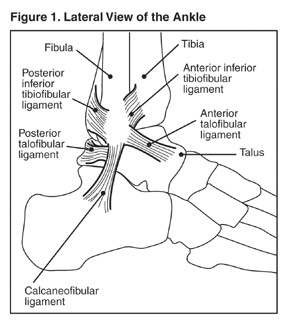A sprained ankle is a very common orthopedic injury. It can happen at any age to athletes and non-athletes. It can happen can happen during a rigorous sporting event, or during a simple task, such as stepping off a sidewalk.
The ankle has a group of ligaments that hold the ankle bones in position. These ankle ligaments help keep the foot from moving in directions for which it was not designed, such as twisting, turning, and rolling.
Ligaments are elastic and can stretch a limited amount before retracting to their normal length. A sprain occurs when forces stretch a ligament beyond its normal range. During a severe sprain the elastic fibers within the ligament will tear.
Symptoms of an Ankle Sprain
The primary symptom is pain in and around the ankle.
The pain makes it difficult to walk or move the foot. There may be swelling and bruising of the ankle as well.
The amount of pain depends on the amount of stretching and tearing of the ligament.
Instability of the ankle may occure if there has been been complete tearing of the ligament or a complete dislocation of the ankle joint.
The damage to the ligaments do not show up on x-rays, so x-ray cannot diagnose an ankle sprain.
However, the symptoms of ankle sprain can be simllar to a bone fracture so your doctor may order an x-ray to rule out the presence of a fracture.
Treatment of an Ankle Sprain
The swelling and pain following an ankle sprain may only last 2-3 days, but complete healing of the joint can take much longer, as long as 4-6 weeks.
Crutches may be necessary during this time to avoid pain and help the ankle joint to recover. Depending upon the grade of injury, the doctor may recommend removable plastic devices such as castboots or air splints.
Nonsteroidal anti-inflammatory drugs (NSAIDs), such as ibuprofen, may be used to control pain and inflammation.
R.I.C.E mesures may also be recommend:
- R = Rest your ankle by not walking on it.
- I = Ice should be immediately applied. It keeps the swelling down. It can be used for 20 minutes to 30 minutes, three or four times daily. Combine ice with wrapping to decrease swelling, pain and dysfunction.
- C = Compression dressings, bandages or ace-wraps immobilize and support the injured ankle.
- E = Elevate your ankle above your heart level for 48 hours.
Rehabilitation is used to help to decrease pain and swelling and to prevent chronic ankle problems. Talk with your doctor about personalized treatment options.
All ankle sprains recover through three phases:
- Phase 1 includes resting, protecting the ankle and reducing the swelling (1 week).
- Phase 2 includes restoring range of motion, strength and flexibility (1-2 weeks).
- Phase 3 includes gradually returning to activities that do not require turning or twisting the ankle and doing maintenance exercises.
Prevention
- The best way to prevent ankle sprains is to maintain good strength, muscle balance and flexibility.
- Warm-up before doing exercises and vigorous activities
- Pay attention to walking, running or working surfaces
- Wear good shoes
- Pay attention to your body's warning signs to slow down when you feel pain or fatigue
Source: Vivacare
Last updated : 12/1/2022